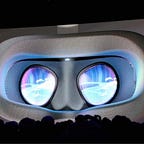Steam VR will run inside Microsoft Mixed Reality headsets!
It’s official now that Steam VR will run inside the Microsoft Mixed Reality headsets. If you have a lower end computer, it will run at 60hz. If you have a higher end computer it will run at 90hz. The headset by itself will cost $299, but for Steam VR you will want the controllers as well and the bundle that includes the controllers costs $399. There are no base stations, the two cameras on the front of the headset track the users position in space and those same cameras also track the position of the controllers in your hands. The controllers also feature inertia tracking and more buttons than the HTC Vive features, and the obvious is that unlike handtracking you can continue to hold a virtual item when your hands are occluded from the tracking cameras. I do sort of wonder how easily this will work in conjunction with a body tracking sensor on the shelf to bring more of your real movements into virtual reality. So what really is the future of the Valve Lighthouse if we are moving to inside out tracking for both the headset and the controllers. I think that at one point we were wondering if the controllers would be tracked via base stations and now we know they are tracked by the headset, is that enough to give tracking that is equal to the quality of the Valve tracking system or not? Will people still prefer the Lighthouse 2.0 based tracking systems or will that type of technology go away because of the increased cost of creating base stations.
The VR PC backpack idea wasn’t really straight forward with the Oculus Rift because the tracking cameras had to plug into the PC, and that means into your backpack. With Vive the tracking cameras were wireless and with products like TPCast and Intel’s wireless VR system you had the promise of a wireless Vive, but it’s portability was always limited to wear you could reliably set up base stations.
So I am really I am really happy now at the prospect of being able to set up VR very quickly where-ever I am. I’m also excited about the prospect of TP-Cast like product making the Microsoft mixed reality headset into a wireless headset.
I feel like it’s a backwards step to announced a 60FPS and a 90FPS solution. Why can’t you do 120FPS on an old PC like the Playstation VR does essentially with reprojection?
Oculus is currently still on sale at $399, but it’s real price is $499 and the Vive price has dropped to $599, but you have to wonder if consumers are going to still opt to pay an extra $100 or an extra $200 for a Vive or Rift over a Microsoft Mixed Reality headset. I don’t think I would. Especially not since Microsoft Mixed Reality headsets play Steam VR.
I have heard from people at Viveport that Viveport intends to support all headsets, so you should expect that will include Microsoft Mixed Reality headsets in the near future, and I’ve also read that the people at Oculus Home want to provide software to headsets beyond the Rift and the Gear VR so that may or may not include Microsoft Mixed Reality headsets. Will the folks at Revive support the Microsoft Mixed Reality headsets in the meantime?
What’s going to happen with OSVR now that Microsoft Mixed Reality headsets are moving into it’s price range?
How will this effect the price of all in one headsets such as the Daydream Vive headset, and the all In one Oculus headset, with each featuring inside out technology for position tracking. Besides all of this Apple is about to announce new products, and since we have seen the HTC Vive being used in Apple commercials for their new Mac Pro workstations it Is entirely plausible that Apple is about to announce AR glasses that will run Steam VR apps.
I don’t know if the people at AR headset makers like Meta and ODG are thinking about supporting Steam VR apps or traditional VR, but I hope they are because inherent in the name of “Microsoft Mixed Reality” is the idea that Augmented Reality and Virtual Reality apps will run on a single headset. So why would consumer’s reasonably pay $700 to $1000 for a headset that only did AR when they can possibly have AR & VR headset with internal position tracking and motion controllers that runs Steam VR and perhaps also Hololens apps for $400?
There still going to be plenty of reasons for people to think about getting a premium headset that costs more than $400. That might be because of higher frame rates (120FPS or higher) higher resolution, newer lightfield displays that are easier on the eyes and feature better 3D, eye tracking for foveated rendering and eye tracking for user interfaces, pupil dilation, eeg, ecg, and emg sensors for tracking your brainwaves, heart rate, and facial muscles. There will be clothing that features body tracking and perhaps there will always be an option for additional accessories such as wall mounted depth sensing cameras that can capture your full body movement and translate that into the VR AR internet.
We haven’t yet seen whether or not these Microsoft Mixed Reality headsets are actually capable of running Microsoft Hololens type apps, but if Microsoft has been planning to let you run all of Windows in 3D in both AR & VR then it makes a lot of sense that Apple‘s new devices might include glasses that let you run either iOS, or Mac OS, or both, or some new Apple 3D Operating System. https://www.macrumors.com/2017/08/28/apple-september-12-event-cnbc-sources/
All in all I think this is great news for today!
https://blogs.windows.com/windowsexperience/?p=151318?ocid%3DBlogSupport_soc_omc_win_tw_Link_lrn_82817&utm_source=tw&utm_medium=organic&utm_campaign=cmg_as
